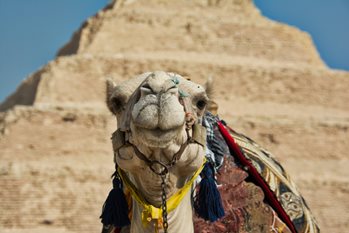 The opening of Vizier Mehu’s richly-decorated tomb at the necropolis of Saqqara offers new insight into daily life in Ancient Egypt.
The opening of Vizier Mehu’s richly-decorated tomb at the necropolis of Saqqara offers new insight into daily life in Ancient Egypt.
Amateur and professional Egyptologists alike have heralded 2018 as a banner year. In addition to the discovery of a sealed sarcophagus, an ancient village, and a new colossus of the prolific Ramses II, Egypt’s Antiquities Ministry green-lighted the opening of the tomb of Vizier Mehu in Saqqara in September.
If Pharaohs were living gods on earth, the Vizier oversaw the day-to-day administration of the mighty Egyptian empire. His duties included oversight of all matters agricultural, judicial, military, financial, interior, religious, and architectural. The final aspect of a Vizier’s work -- overseeing the massive construction projects -- was his own lasting legacy, as he designed and executed the intricate construction of the Pharaoh’s palaces, temples, and their all-important tombs.
A Vizier had to be well-educated and blessed with an even and unemotional temperament. Most Viziers were recruited from the ranks of younger royal sons, though the most famous of Egypt’s viziers, Imhotep, worked his way up from very humble origins.
Mehu’s administration appears to have spanned the reigns of two Pharaohs: Teti I (2323-2291 BCE) and his son Pepi I (2289-2255 BCE). These 6th Dynasty rulers seized the throne when the 5th Dynasty ruler died without a direct heir. These Pharaohs were focused on consolidating the power and reach of their centralized government — a task that would have preoccupied much of Mehu’s time and focus. Their success is reflected in the many public works erected, particularly in Pepi I’s reign, and in the splendor of Mehu’s own tomb.
Discovered in 1940, Mehu’s richly-decorated 4-room tomb offers visitors a keen insight into what life in Egypt was like four millennia ago. The walls of the tomb are decorated with detailed scenes, painted in vibrant colors, their colors still intact and today expertly illuminated. One mural depicts Mehu’s 48 different titles as illustrations of him with the attributes of his office. He is also portrayed taking part in a lively dance. The wall paintings not only depict traditional scenes of Mehu as a faithful servant of both Pharaoh and the Gods, but also show us views of Egyptians cooking, hunting, engaging in agricultural work such as planting and harvesting, and fishing in the bountiful Nile River with nets.
Mehu’s tomb consists of four rooms leading into a wide courtyard. The Vizier is buried with his son, Meren Ra and his grandson, Hetab Kha. This new tomb with its lively and insightful decorations is a welcome addition to the already-impressive list of tombs at Saqqara, once the bustling capital of Ancient Egypt.
Mehu’s Tomb is a reminder that Ancient Egypt guards her many secrets well, and that she still has the capacity to surprise and enthrall us.
Visit Saqqara and Mehu’s Tomb on Alexander + Roberts
Visions of Egypt, as well as its new itinerary
Between the Paws of the Sphinx. This land and cruise combination tour includes a private field talk by renowned Egyptologist, Ashraf Mohie El-Din, as well as the usually off-limits opportunity to stand between the paws of one of Ancient Egypt’s most iconic and enigmatic monuments: The Sphinx. Contact one of our knowledgeable reservation agents to discuss this and other itineraries.